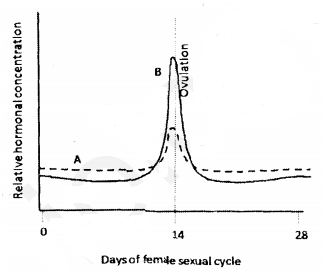 Multiple Choice Questions
Multiple Choice QuestionsThe graph represents relative plasma concentration of hormone (A and B) during reproductive cycle in a normal female. Which one of the following combinations is correct?

A is FSH and B is estrogen
A is estrogen and B is LH
A is FSH and B is LH
A is LH and B is FSH
Capacitation of sperms in humans
Occurs during copulation
Occurs after the aerosome reaction
Takes place in the ampulla of the oviduct
Takes place in the epididymis of testis
Which one of the following is responsible for the ejection of milk from mammary glands in mammals?
Oxytocin
Prolactin
Serotonin
Melatonin
The T-wave of ECG indicates
Atrial depolarization
Ventricular depolarization
Ventricular repolarization
Atrial repolarization
Blood group type A antigen is a complex oligosaccharide which differs from H-antigen present in type O individual by the presence of terminal
Glucose
Galactose
N-acetyl galactosamine
Fucose
C.
N-acetyl galactosamine
Blood group type A antigen is a complex oligosaccharide which differs from H-antigen present in type O individual by the presence of terminal N-acetyl galactosamine.
An experiment stimulates a nerve fibre in the middle of an axon and records the following observations. Which one of the observation is correct?
Nerve impulse is travelling in a direction towards cell body.
Nerve impulse is travelling in a direction towards telodendrons.
Nerve impulses are travelling in both the directions opposite to each other.
Nerve impulse is not moving in either direction.
Desert animals have longer loop of Henle compared to that of humans. It may be due to the following reasons:
A. Long loop of Henle is associated with greater amount of vaspressin secretion.
B. In long loop of Henle, the counter-current exchanger is more effective.
C. Long loop of Henle conserves more water.
D. Long loop of Henle stimulates production of angiotensin II.
Which of the above reason(s) is/ are correct?
A and B
B and C
C and D
Only D
A eats a large serving of cheese having high amount of sodium. He hardly drinks any fluid. Inspite of this, the water and electrolyte balance was maintained. Which one of the following explanation is correct?
His aldosterone was decreased and alcohol dehydrogenase (ADH) was increased.
His aldosterone was increased and ADH was decreased.
There was no change in either of the hormones.
His sympathoadrenal system was stimulated.
The blood volume decreased when a mammal was bled rapidly. However, the cardiovascular changes resulting from hemorrhage could be minimized by the following compensatory mechanism:
A. Increased cerebral blood flow.
B. Reduction of baroreceptor activity stimulation of chemoreceptors.
C. Reabsorption of tissue fluid in blood.
D. Increased release of enkephalins and beta-endorphins.
Which of the above is/ are correct?
A and B
B and C
C and D
Only D
The stomach of a person was partially removed during surgery of a gastric tumour. Despite taking a balanced diet, the person developed anemia. Following possible explanations were offered:
A. Lower gastric secretion inhibits folic acid reabsorption
B. Protein digestion was disturbed in partial gastrectomy.
C. Lower HCl secretion from stomach reduced iron absorption.
D. Lower secretion of intrinsic protein factor from stomach reduced Vit B12 absorptions.
Which of the above explanations were correct?
A and B
B and C
C and D
A and D
